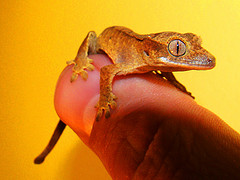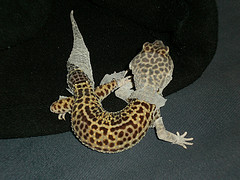This week, Gecko Time addresses two commonly asked and important questions about gecko husbandry. Please keep those questions coming by submitting them on the Contact page.
[ad#sponsor]
Question 1:

Do you know if a female crested gecko can be kept with a flying gecko successful? I have a 90 gallon vivarium with lots of foliage and I keep my huidity between 70 to 75%. I know that flying geckos like temperatures a little warmer than cresties but I keep the vivarium between 74 to 82 degrees. Thanks for any advice.
Dan Martindale responds: I would never mix a flying gecko and a crested gecko. Both geckos tend to be aggressive toward other species. Both species may live in the similar environments, but something as simple as feeding could be a problem. The diet of the flying gecko is entirely insects, while the crested gecko eats mostly CGD (Crested Gecko Diet). The crested gecko would end up eating far too many insects and could easily end up obese. Also, since they would compete for the same spaces, an ideal hiding spot would be fought over. The healthy temperatures for each species are far apart. The maximum safe temperature for a crested is 80° and the best temperature to raise flyers in is 85-90° for day temperatures. Both species would do ok with night temperatures in the 70-75 range, but the crested gecko likes cooler temps. In a large enough vivarium, setting up these temp ranges could be done.
If something like this was attempted you would need a backup cage all ready to go for one of them in case things did go badly and they needed to be separated. Make sure to have medical supplies for the animals on hand in case things get really nasty. Know where your local vets are and the hours they keep if either animal ends up severely injured. Even if things go well for awhile, it could all go badly weeks, months and even years later. That is a lot of time to worry about potential conflicts and have a backup cage ready.
Garrick DeMeyer responds: There is always a risk when keeping reptiles together, whether they are the same species or different species. Crested Geckos do like cooler temperatures than Flying Geckos, but with a 90 gallon enclosure, there is enough space to create a fairly wide temperature gradient. Crested Geckos do get a bit larger than Flying Geckos, but they don’t generally try to eat other lizards, unless there is a huge size difference. They would occupy the same niche in the enclosure, however. There may be territorial disputes for the prime locations in the cage. If both geckos are female, that would probably help. Mixing species requires a lot of trial and error. Sometimes it works, sometimes it doesn’t. As long as the both require a similar environment, there isn’t a big size difference in the animals, and the enclosure is large enough, they would most likely be fine. Keep a close eye on them to make sure they are both feeding, and there is no obvious signs of stress. It is also a really good idea to quarantine the flying gecko and check for parasites as nearly all of them that are available are imports.
Question 2:

How do you help the gecko shed easier? Mine’s skin is stuck around its leg.
Tony Casler responds: If one of my geckos has a bad shed there are two methods I use to help them out. First I will mist their tub with water, typically the extra humidity will soften up the skin and allow them to finish unassisted. If they still have retained shed the day after misting, then I give them a warm bath and carefully remove the skin with tweezers. I use a six quart tub, filled with enough water to cover the affected area, but make sure it is not so deep that the gecko can’t easily hold its head above the water line. To avoid temperature shock the water should be neither hot nor cold. Use a thermometer or temp gun to ensure it is between 80 and 90 degrees.
Aliza Arzt responds: Some geckos seem to have a harder time shedding than others, especially around the legs, toes and eyes. First, make sure you have a humid hide in the cage at all times for your gecko, which I am assuming is a leopard gecko. This is an enclosed hide, usually made from a plastic food container. Cut a hole cut in the top or side and put some coco fiber, paper towel or sphagnum moss on the bottom. Spray it when it dries out. When your gecko is shedding, encourage it to go into the humid hide. If shed is left in any area, gently grab hold of the loose end and pull the shed off . This will not hurt the gecko, but may annoy it a bit. You may need to use your finger nail to gently scrape off the skin around the toes. A warm soak may help as well. Some people like to use tweezers to remove the skin, but I would recommend against using it near the face since the gecko could move suddenly and get poked in the eye.
About our Experts
Thank you very much to our experts for answering these excellent reader questions! Here is a bit more information about them:
Aliza Arzt is one of Gecko Time’s editors. In her other life she is a home care speech therapist living in the Boston area. She has been breeding leopard geckos since 2005 and has recently been successful in breeding African Fat Tail and Coleonyx geckos as well. Other interests which she pursues in her copious free time include work in ceramics, practicing aikido and surfing the internet. Her live and ceramic geckos can be found at http://geckcessories.wordpress.com.
Tony Casler has kept amphibians and reptiles for 15 years. He keeps a variety of amphibian and reptile species, with a focus on Phyllomedusine and Dendrobatid frogs, Boa constrictors, and Leopard geckos.
Garrick DeMeyer owns and operates CrestedGecko.com and Royal Constrictor Designs. He has a BS in Biology from the University of Wisconsin-Stevens Point. Over the past 20 years, Garrick has bred dozens of species of reptiles, including many gecko species, and has produced thousands of babies during that time.
Dan Martindale has been keeping herps since he was 8 and loved working with various lizards, geckos, skinks, frogs and toads and many others. Currently he has a small business and hopes to offer a wide variety of captive bred reptiles. He does not raise his animals on a simple diet of just 1 bug; his critters enjoy a varied diet of about 5 regular prey types and a few extras like Silkworms now and then. He is currently working with leopard geckos(Eublepharis macularius), crested geckos(Rhacodactylus ciliatus), flying geckos (Ptychozoon kuhli) and mourning geckos (Lepidodactylus lugubris). He is a co-owner of Chaotic Nights Reptiles. One day he hopes to be able to do what he loves for a living and a hobby.


Big thanks to the folks who answered these questions!
What is the best way to put substrate? On the bottom or near his hideout?